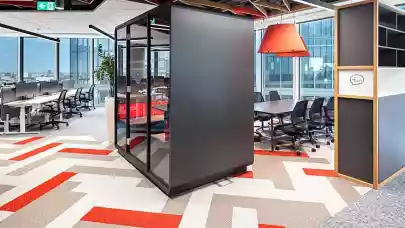
While prior to the pandemic, as many as 76% of organisations employed people to work exclusively in the office, only 24% of organisations surveyed by Colliers say they will adopt the same hiring strategy in the future. With this significant change, we are seeing new developments in the labour market – employees’ expectations towards employers are changing, as well as the way office space is designed, which today must meet the needs of a hybrid workforce. The Colliers report Hybrid and Beyond, prepared in association with partners HRK S.A. and Well.hr, shows the most important aspects of implementing hybrid work in companies operating in the Polish market.
Hybrid prevails
Even before the pandemic, some companies were using a hybrid work model, allowing their employees to connect remotely, work flexible hours or use electronic document workflow. The pandemic has forced the introduction of this model also in organisations that previously worked exclusively from the office.
“Today, few companies work exclusively in onsite or fully remote modes. Research shows that to date up to 89% of organisations have implemented a hybrid work model. The majority of their employees work remotely for two or three days a week, 24% work primarily from the office, and 18% work predominantly remotely. At the same time, 21% of surveyed companies plan to increase the scope of work carried out from the office in the future,” says Karolina Dudek, Associate Director, People & Places Advisory, Colliers Define.
A new employment strategy
Trends in the labour market suggest that the place where job duties are performed is no longer a factor in employment. According to the Colliers report, in the long term, 33% of companies intend to hire remote workers who live not far from the office, and 34% say they are willing to recruit remote workers from anywhere in Poland. Despite the global opening of the labour market, the least popular strategy, which only 10% of surveyed organisations plan to implement, is to hire people working from anywhere in the world.
“The COVID-19 pandemic has greatly affected the way employers look for workers. They have opened up to candidates who are willing to travel long distances to work at the company’s office, for example, twice a week. Companies are now searching for different skills and aptitudes than before the pandemic. Employees today are expected to have digital skills that allow them to efficiently operate the devices and systems used in the organization,” says Piotr Mazurkiewicz, Managing Partner, HRK S.A.
Employees are becoming more demanding
Organisations are getting used to the new vision of work and are noticing that a hybrid model is a must-have in the job description for many job seekers. In the hybrid work model, however, one in five organisations plans to shift to more office-based work. Why?
“Already, 71% of surveyed organisations say they are encouraging employees to work from the office more of the time than before, or they will start doing so in the near future. This may indicate growing awareness that, from the perspective of business needs, aspects such as mutual contact between employees in the office, information exchange and building brand loyalty are particularly important,” explains Dorota Osiecka, Partner at Colliers and Director of the Colliers Define platform.
However, this is not an easy task — even a partial return to offices is still a topic of heated discussion among employees.
“It turns out that 66% of organisations encouraging employees to return to the office face resistance because employees have ‘settled’ into a remote work system. They value domestic silence and the absence of distractions. They explain that this mode positively affects their individual productivity and work-life balance. So, companies are using all sorts of incentives to encourage people to show up at the office. Today, however, ‘fruit Fridays’ or ‘pizza Tuesdays’ are not enough. Rather, it is by providing opportunities for face-to-face contact with co-workers in conditions tailored to the needs arising from the work styles of specific employees that organisations are able to create a space that can compete with the home office and encourage employees to make the often time-consuming journey to the office,” Dorota Osiecka adds.
Working from home, which is preferred by employees, also carries risks.
“We use the time saved from commuting to perform work, and it’s not uncommon to stretch our work hours into the evening and lose our work-life balance. This increases the risk of exhaustion and professional burnout. Due to the changes, new and previously unknown phenomena have also emerged, such as digital stress and fear of disconnection, which are the result of too intensive and prolonged contact with technology, as well as poor work organisation,” says Joanna Kotzian, a wellbeing strategist, co-founder of Well.hr.
The office reinvented
The proliferation of the hybrid work model has also forced changes in office space. Back in the pre-pandemic period, individual workspaces predominated in offices and accounted for about 70% of the space, while only 30% of the space – smaller and larger meeting rooms and common areas – was devoted to building relationships among employees. Today, there is a strong emphasis on creating zones that foster collaborative work and spontaneous meetings that build relationships within teams and their creativity. For example, special team rooms, or conference rooms with work areas and computer access, are being created in offices where employees can work together on a project.
In addition, companies are increasingly investing in AV infrastructure so that meetings can be held in both onsite and hybrid models. Since it is rare for all employees to be in the office at the same time, many companies are choosing to move away from desks assigned to specific employees and introduce flexible workstations. Also popular are focus rooms, which are small rooms, often in the form of mobile phone booths, which are ideal for holding small meetings.
“Today, organisations are faced with the challenge of creating a space that is not only a place for employees to perform their jobs, but also a unique experience – an experience of the company and its organisational culture, the team, and the workplace itself. I am talking here about social glue,” points out Małgorzata Michalczyk, Head of Administration, Colliers.



